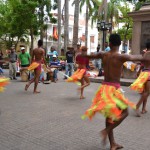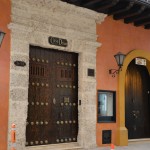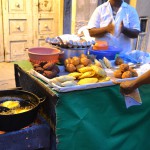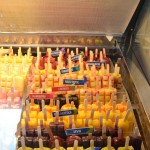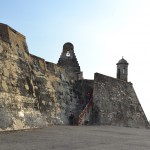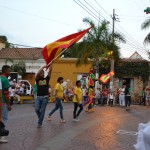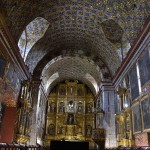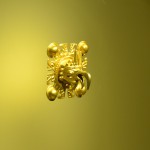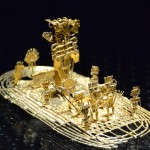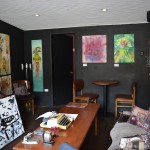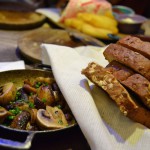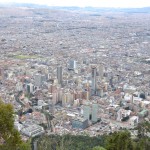From Curaçao, we flew via Bogotá to Cartagena on the Colombian Caribbean coast. Cartagena was hot and humid, but definitely worth seeing. The old walled city where we stayed is very well preserved / restored. The narrow streets are lined with houses and mansions from colonial times, typically with a central courtyard in the middle. We did a guided walking tour through the city the first day, which was as great in pointing out some of the more impressive buildings, which were mostly former homes of aristocrats or former convents. Also featured on the tour were some points of interest about Gabriel Garcia Marquez’s life and work, whose book “Love in the Time of Cholera” had been one of the reasons for visiting – though not explicitly set in Cartagena, it is heavily inspired by the city. Our guide also recommended another short book by him, again set in Cartagena, which we both read in our time there: “Of Love and Other Demons”.
On our tour and in the next days, we explored not only the old town, but also the adjacent neighborhood of Getsemani. It is still within the historic city walls, but used to be divided from the old town by a bridge. Getsemani was originally the slum, inhabited for example by freed slaves. Today, Getsemani is becoming increasingly gentrified, and it houses the backpacker hostels as well, but is certainly less polished than the old town.
Cartagena seems to be a city that loves to celebrate – every day, there was a stage being set up somewhere, or some kind of dance performance, or simply loud music playing from somewhere. Especially after sunset, when the heat was not as unbearable anymore, the streets were busy with people. While this was not high season for foreign tourists, Cartagena is also a favorite weekend destination for Colombians, and so there is also no shortage of vendors trying to sell touristy trinkets, but also street food, including my new favorite “Arepa con Queso” – A fried corn pocket, filled with cheese.
In order to make best use of this party city, we also took some Salsa classes – one had been a wedding present, but we liked it so much that we booked additional classes for all of the days we were in town. We also went out to dance at Quiebra Canto one night – and as long as there were enough couples on the dance floor, we also dared to try our newly learned steps, which was great fun.
We also had amazing food in Cartagena. Most noteworthy and fancy were the restaurants 1621 (in the courtyard of the Santa Clara hotel, a former convent), as well as Don Juan. Both served really excellent cuisine, highlights included the octopus carpaccio at 1621, and at Don Juan the crab claws, grilled prawns, and octopus with bacon and sour cream.
One additional sight that we visited was the San Felipe fortress just outside of the old town. The biggest Spanish fortress in the new world, it sits on a hill in what used to be swampland. This meant that the defenders of the fortress were aided in their attempts by sickness-carrying mosquitoes. The castle featured a really good audio guide that provided explanations about the layout and the lines of defense of the fortress as well as some important battles that took place here.
On June 2, we flew from Cartagena to Bogotá for a couple of days. Bogotá is mostly a big city, in which we explored the different neighborhoods (La Candelaria, Macarena, Zona G, Zona Rosa, and Usaquen), which have nice restaurants and cafes. Particularly nice was the quaint little Café Usaquen in the neighborhood of the same name. An interesting dining experience was Andrés DC – the smaller downtown outlet of Andrés Carne de Res (since we weren’t in town for the weekend, we couldn’t try the original). Andrés DC is an interesting restaurant / bar / disco hybrid, with a 60-page menu, a roaming band that sings and celebrates at different tables, lots of very unusual decorations, etc. It is very hard to describe this experience, I hope some pictures will help.
We also did some sightseeing, although in comparison to Cartagena there was definitely not as much historic town to be viewed. We went around the historic city center, and visited the museum Santa Clara (a former church, with about a hundred religious paintings across all of the walls) as well as the Botero museum (the most famous artist, who has painted and sculpted exclusively his trademark “voluminous” (i.e., chubby) people, animals, and things). Last but not least, we also visited the gold museum, which is really impressive and showcases a broad range of gold items from Colombia’s pre-colonial times.
We also went up to Monserrate, a mountaintop church overlooking the city. Bogotá is bordered by a steep mountain range on one side. The city itself is already at 2500m elevation, and Monserrate is more than 3000m high. From up there, you therefore have an amazing view over the whole of Bogotá, stretching and sprawling over the hills all the way to the horizon. Going up there was definitely worth a visit.
Some pictures follow.
- Cartagena gate
- Traditional dance
- Casa Drake
- Fried Snacks
- Botero statue
- Paletas!
- Castle
- Salsa club
- Gethsemani
- Church in Bogota
- Gold museum
- Gold museum
- Hipster café Usaquen
- Andrés Carne de Res
- View of Bogota from Monserrate

